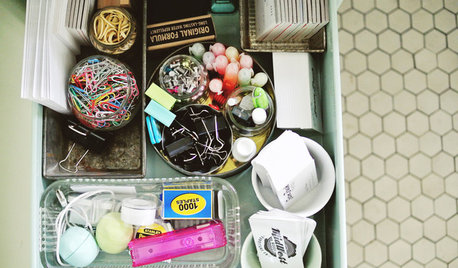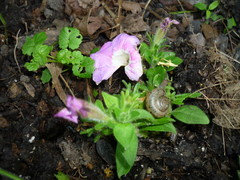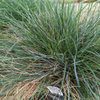how to get rid of pill bugs??
pill bugs are eating away all my bulbs,my iris and chrysanthemum plants.can somebody tell me how to get rid of them??
rema
Comments (84)
trailguide15
10 years agolast modified: 9 years agoLavaLady, I think the two might be different sizes, with the garden DE ground finer. Online there is talk about food grade DE that would include the garden DE since it is put on food. Before you use that you might want to try the tobacco tea. I am having good results with that on my flowers, but it is difficult to know what beneficial critters I am exterminating or running off with that as well.
Here is a link to an ad for a book about DE. The ad has quite a lot of information, so check this out and maybe you can get the book at the library.
http://www.tuirose.com/diatomaceous-earth-book-introduction.phpLavaLady
10 years agolast modified: 9 years ago@ Trailguide15...Thanks a bunch for all your help. I'll have to check out that Tobacco tea. I do like my worms so I hope it won't harm them.
Related Professionals
Maple Valley Landscape Architects & Landscape Designers · Forest Acres Landscape Architects & Landscape Designers · Otsego Landscape Architects & Landscape Designers · Piqua Landscape Architects & Landscape Designers · Rancho Cordova Landscape Architects & Landscape Designers · East Patchogue Landscape Architects & Landscape Designers · Arlington Landscape Contractors · Byram Landscape Contractors · Lorain Landscape Contractors · Lynn Landscape Contractors · Setauket-East Setauket Landscape Contractors · Severna Park Landscape Contractors · Vashon Landscape Contractors · Wilsonville Landscape Contractors · Lauderdale Lakes Landscape ContractorsLavaLady
10 years agolast modified: 9 years agoFYI: based on further research the Diatomaceous Earth (DE) used for cleaning up oil spills is NOT effective for use as a pesticide. Two reasons, although one is enough:
Reason#1: the DE used in oil spills is heat treated which makes it calcinated and therefore ineffective in killing soil-born pests. Calcinated is also not good for you to breathe or have around pets, wildlife and people (i.e., not to be used in gardens). Although Qualisorb says their product is non-toxic, their MSDS says it all.
Reason #2: The particles are too large to be effective. Particles on average should be 12 microns or less.
This all means I must buy the brand name stuff, which is very costly, but I do love my plants.
Many thanks to TRAILGUIDE15 for sending me on the right track.
Kimmsr
10 years agolast modified: 9 years agoApparently there is gross misunderstanding here about Pill Bugs, Sow Bugs, Potato Bugs, Wood Lice, or what ever term is used to identify these crustacians. They primarily live on decaying vegetative waste but may also eat living plant material. However, the majority of the time when these wee buggers are blamed for something they are really innocent and something else caused the actual problem.
Perhaps this linked bit from the University of Kentucky entomologists can help.Here is a link that might be useful: About Pill Bugs
trailguide15
10 years agolast modified: 9 years agoThe tobacco tea seems to be working. My suggestion is to only use it sparingly, not every time you water and then only on the affected plant, not the entire garden. I say go slow with plant choices, only one or a few of each to see if they are attractants or not. Then choose your plants accordingly and you will be able to give up the tobacco tea use and have not eradicated the beneficial organisms along with those you don't want, from the entire garden.
Actually a healthy garden has some of both because what we consider non-beneficial to our garden plants have a usefulness that perhaps we just don't see. Like transformation of detritus to humus and good soil. A healthy balance is what we are looking for and perhaps too many of one plant, a mono-culture, is inviting infestation trouble.
I am going out on a limb and buying another lupine plant and then checking it often, around the clock to see if I can tell what exactly ate all the leaves. It was something small, not a deer. It went over the course of several days from the edges in. Look for future pictures.
I put out the impatiens and so far so good. I did douse them with the tobacco tea while still in the flat the day I brought them home, but that was the last time. I will wait for signs of loss before using the tea again.
The six petunia plants I got at the same time as the impatiens were also doused with the tea, but the first night, still in the flat almost every piece of every bloom disappeared. I do suspect a slug of eating the blossoms leaving the base of the flower still in the sepals which is what I found the next morning. I found a slug in the impatiens when I planted them, maybe the slug got lost--but no extensive damage to those plants. Since then the petunias have formed new blooms but I found snails on the plants today and the woodlice are visible in the daytime on top of the soil around their roots (this photo does not show the woodlice in the large numbers that are present). See photo.
One scenario that we haven't visited is that the potting medium has a component of dead plant material, not fully composted, that attracts the woodlice. I am hoping that is all they are eating and will gladly give blame where it is truly due..This post was edited by trailguide15 on Sun, May 26, 13 at 10:28
LavaLady
10 years agolast modified: 9 years ago@ kimmsr... your article says it all: pill/sow bugs eat young plants. Reading through the thread I see that people's young bean sprouts are being eaten. If you are aware of the size of a bean sprout then the usually minimal damage done by pill bugs is devastating on a sprout. I have seen with my eyes the damage that pill bugs can do. Once there's an infestation, they can strip a new plant down to nothing overnight. No they down eat mature or super high plants but in my garden they are definitely the culprits. I have never seen a slug trail, lady bug, aphid, grubs or any known pests in my garden soil, but I have way more than my fair share of pill bugs. My hostas were completely killed, because they ate away at the base of each new leaf, and when a new one came out, they went at it before it even had time to unfold. No leaf, no energy which meant this year, I had no Hostas in my side yard. I don't need any links to tell me about pill bugs. I have eyes and I've seen the damage they do. People on the forum have provided more than sufficient evidence that pill bugs damage fresh growth and make it impossible for some plants to even move beyond seedling stage. I've started my course of DE and I wish good luck to all the other gardeners who have provided insightful information on how to help control these crusty critters:)
Kimmsr
10 years agolast modified: 9 years agoTobacco Tea, a means of getting the nicotene, has been on a list to be banned for quite a number of years. The synthetic nicotenoids have been found to be very bad for most of our beneficial insects and pollinators.
No one today should be using, or recommending for use, any nicotene sulfate products whether home made or not.Kimmsr
10 years agolast modified: 9 years agoTobacco Tea, a means of getting the nicotene, has been on a list to be banned for quite a number of years. The synthetic nicotenoids have been found to be very bad for most of our beneficial insects and pollinators.
No one today should be using, or recommending for use, any nicotene sulfate products whether home made or not.trailguide15
10 years agolast modified: 9 years ago@kimmsr
do you have any methods to keep pests from eating my plants that is not harmful to the beneficials ?This post was edited by trailguide15 on Mon, May 27, 13 at 11:34
Kimmsr
10 years agolast modified: 9 years agoWhat to use depends on which pest you have, but most every poison that controls the insect pests will also kill any beneficials. The few very selective materials, biological controls, are not very effective once the target insect gets a few weeks old.
Your best defense from insect pests is strong and healthy plants growing in a good healthy soil and a diverse habitat that attracts a wide variety of predators of insects. I can recall that for many years we have been told to keep those "weeds" on ther matgins of our property cut down since they harbor insect pests and now we spending several million dollars to study if leaving those "weeds" (others call them wild flowers) is better because they can provide another source of food and shelter for the pollinators, as well as the beneficials and predators.Kimmsr
10 years agolast modified: 9 years agoWhat to use depends on which pest you have, but most every poison that controls the insect pests will also kill any beneficials. The few very selective materials, biological controls, are not very effective once the target insect gets a few weeks old.
Your best defense from insect pests is strong and healthy plants growing in a good healthy soil and a diverse habitat that attracts a wide variety of predators of insects. I can recall that for many years we have been told to keep those "weeds" on ther matgins of our property cut down since they harbor insect pests and now we spending several million dollars to study if leaving those "weeds" (others call them wild flowers) is better because they can provide another source of food and shelter for the pollinators, as well as the beneficials and predators.trailguide15
10 years agolast modified: 9 years agoAfter several late evening inspections, here is what I found. This year I planted violas, lobelia, impatiens, bee balm/monarda, forget-me-nots/myosotis, lupine, Easter lily bulbs and daffodil bulbs. So far what has survived is lobelia, bee balm but with holes in foliage, forget-me-nots, lily and daffodil bulbs, impatiens.
This is my hypothesis: I think the flowers (I don't plant vegetables in this garden) that have not been eaten by the wood lice are not appetizing to the wood lice and other pests that are in my garden such as snails, slugs, some kind of grasshopper, or others. I think that all it takes is one good bite or at least several small ones and the plant sends out a signal that it is being attacked or is dying--look this up, science does not reject this hypothesis, and then the wood lice attack full force. I lost every bit of every viola, the lupine, and the petunias are finished soldiers, lying on the ground being eaten alive as it were. I noticed on the petunias after much chomping and they fell over that something had eaten the soft flesh completely around the major stem leaving only the few sort of woody strings in the center. This is not a casual picnic but all out siege. My plants were not seedlings of a stem and a few leaves, but nursery plants of somewhat substantial size with many leaves, blooms and buds on each plant, but the girdling or loss of all the leaves of the plant would not allow any size plant to live. The lupine and violas were eaten leaves and blooms first. I can't say what took the first bite, but very definitely the wood lice ate the injured bodies while they were still standing and still seemed viable if I could have stopped the wood lice.
I am going to buy one plant at a time of new species to test the waters and proceed accordingly.Tiffany, purpleinopp Z8b Opp, AL
10 years agoTrail, yours really is a tale of woe! Have you added bagged peat to your ground? Does the ground ever dry out? Curious where in the country you are, if you don't mind saying. I see a lot of pill bugs around my yard, but with few exceptions they don't eat plants, and I've never seen them so thickly in the ground as your recent pic. Lettuce does come to mind. The tiny seedlings that sprouted in place from scattered seed were no match for these guys - either them or slugs, which I hardly ever see.
Are you sure there are no bunnies hopping through? Decapitation is their milieu! Squirrels are also suspect sometimes.
Have you considered putting a bird bath near the worst areas? This would attract more to your yard, hopefully sometimes with appetites! Every morning there are birds here in the yard, they forage among the leaves/mulch in the beds for bugs.
I'm wondering if your garden areas are relatively new, and a natural balance of things has just not had time to establish. I tried to skim back to re-familiarize myself, but didn't notice anything about that aspect of your gardens, if it's already been said.
trailguide15
10 years agolast modified: 9 years agoI live in Ohio, in the woods. The garden is just a place outlined with stones from the edge of the woods. No improvements. It has been mulched a couple years but I am giving that up in favor of covering the ground with plants to crowd out the weeds. The garden is at the bottom of a hill in about an hour of sun per day, otherwise medium to deep shade. It is not always wet though. We have drought in summer more than not. Since we have to buy water there is no watering gardens then. So maybe this is a hopeless case. I would like to get just a little border of something perennial going and so far am aiming to the myosotis/forget-me-nots. They have not had one wood louse on them or near them so far. But they only bloom in spring and I wish for something blooming all growing season. This year will be impatiens but want to give up most annuals here because of watering issue. I planted some daffodil bulbs that were Easter plants in pots and the leaves died a natural death with one still living, so maybe that is an option also. As well with the Easter lilies--no signs of gnoshing there, knock on wood. I wanted iris, but the first post or so says no. Lilies of the valley, ostrich fern and Lady fern are uneaten as well, and they were rootstock, very tiny plants right now, but healthy. So little by little I am finding things that will work, that don't attract the hungry garden eaters. Am going to try heuchera/coral bells also and keep going to the nursery to see what they have blooming new all summer. One plant at a time. .
trailguide15
10 years agolast modified: 9 years agoForgot to say, we have porch cats, like barn cats, that keep the rodents and reptiles away from the house. The garden is close. No rabbits, no chipmunks, no mice, a dead vole now and then, no groundhogs, squirrels are smart and stay in trees, a few toads to eat the crickets, frogs that stay in the pond mostly, fox, and deer passing through infrequently. We have raccoons and oppossums that eat fallen birdseed and cat food when they can get it which is not often. I feed the birds all year and there is always water available for them. They don't eat woodlice, at least not from my garden. But my plants had holes in them when they didn't just disappear.
Tiffany, purpleinopp Z8b Opp, AL
10 years agoThat sounds really frustrating! Also makes me wonder if at least sometimes in the past, when I've blamed bunnies, that could have been a wrong assumption. A wooded setting like that should be home to plenty of birds. Doesn't sound like a situation you've inadvertently created, so there's nothing I know for you to stop doing - or do more of - from what you've described. Can't think of any other advice at this point, sorry.
The spot you describe sounds perfect for woodland natives. The ones I remember so well from the southern part of the state, like Trillium, Polygonatum, Podophyllum, Mianthemum, Phylox divicarta, Columbine... for some reason my mind is stuck on spring, but that's when most of the deep shade natives bloom, AFAIK. Then there's those who's origins I don't know, like Polemonium, Pulmonaria, Bergenia, Hosta, Lamium, Veronica, Thalictrum, Brunnera, Heuchera, and whatever they're calling bleeding hearts now, no longer Dicentra I think.
I used to live in OH and had a lot of shade plants at my last place before moving to AL. LOV is a notorious (exotic) thug in the right conditions, and I think ostrich fern might be too. Adding more of these to a natural area might not be a great idea but can't argue that they are attractive-looking plants - especially if they're all that's left standing after these nosh-fests.
We are visiting OH in a couple weeks. My only regret about the trip is that it had to wait until school let out. I don't think we'll see any of the flowers I mentioned when we go hiking in Hocking Hills. All of my pics of them are from April(s) and May(s).
I'm curious about your moniker. Do you actually work as a trail guide?
trailguide15
10 years agolast modified: 9 years agoI love the woodland wildflowers too and do plan on some of them although I am unsure how well they will do with my noon hour of sun and our summer droughts. Most of the ones I am familiar with live in the deep shade. I have been reading sort of biographies of the woods and some field guides by different authors to see what grows on the edge or in openings, knowing that I have the right soil and that those plants should thrive in my little space. When I can find them for sale as nursery cultivated I want to plant the species of the plant, not a hybrid.
Yes, I am a trailguide, naturalist for over 30 years off and on.
We also have another issue that is not pill bugs, someone planted a huge field of daylilies, the plain orange ones, as groundcover to stabilize a hill under our road. They are invading everywhere and don't bloom in the shade. I would rather have the native invasive fern, actually I am counting on that, it belongs in the woods at least. That location will never be able to get by on just spring wildflowers. I am also hoping that the fern will shade out the bush honeysuckle as we are able to cut it down. It is everywhere along the edge of our woods. I want to plant some other shrubs and small trees with natural bird food, deciduous holly, dogwood, a rhododendron, fragrant sumac etc. to have more diversity to look at as well as support the mixed woods biota. And I would like to be able to see into the woods and out to the river, not just a wall of green surrounding me and holding out the breezes.
I hope this explains my take on the wood lice issue. I am not looking to radically change the habitat, but only to enhance it a bit. They are welcome to stay if they eat only the tons of detritus available and not my bought with great price nursery plants.This post was edited by trailguide15 on Thu, May 30, 13 at 12:20
gbandjb
10 years agolast modified: 9 years agoSomething was eating my zinnias. I had seen a few pillbugs on my zinnias previous years. However I wasn't sure if it was pillbugs or slugs killing my plants. I used the beer in the bowl method because I have used that method other years to get rid of slugs. To my surprise hundreds of pillbugs (and a few slugs) were in the bowl! So far the plants, even though severely maimed, are holding their own.
gbandjb
10 years agolast modified: 9 years agoSomething was eating my zinnias. I had seen a few pillbugs on my zinnias previous years. However I wasn't sure if it was pillbugs or slugs killing my plants. I used the beer in the bowl method because I have used that method other years to get rid of slugs. To my surprise hundreds of pillbugs (and a few slugs) were in the bowl! So far the plants, even though severely maimed, are holding their own.
maraloew
10 years agolast modified: 9 years agoI think by now even the non-believers will believe that pill bugs eat plants. I've been gardening for many years, but this spring has been the worst for pill bugs eating plants they've never touched before. The zinnia seedlings I planted in my flower pots are thriving, but the ones I transferred to garden beds are being devoured by pill bugs, as are my cucumber starts. I have built fences to ward off groundhogs and I have netted areas to ward off birds, but these bugs have no restraints. Last year we had a drought, and I have welcomed the rain this year, but I've never seen such devastation. I will use the beer drowning method, starting tomorrow!
maraloew
10 years agolast modified: 9 years agoI think by now even the non-believers will believe that pill bugs eat plants. I've been gardening for many years, but this spring has been the worst for pill bugs eating plants they've never touched before. The zinnia seedlings I planted in my flower pots are thriving, but the ones I transferred to garden beds are being devoured by pill bugs, as are my cucumber starts. I have built fences to ward off groundhogs and I have netted areas to ward off birds, but these bugs have no restraints. Last year we had a drought, and I have welcomed the rain this year, but I've never seen such devastation. I will use the beer drowning method, starting tomorrow!
Tiffany, purpleinopp Z8b Opp, AL
10 years agoYes, I've been converted to a believer by this discussion. And that the beer thing really does help, not for total elimination, but for reducing them to a "normal" amount. I don't blame folks with a heavy infestation for wanting to do something about it. Best of luck to everyone!
I wonder if some less expensive type of yeasty fermentation might also do the job. Even cheap beer isn't cheap.
trailguide15
10 years agolast modified: 9 years agoAnyone can collect FREE yeast from the air. Mix equal amounts of flour and water in a non-metal bowl. Cover with a cheesecloth or tight weave net to keep out twigs, bugs etc. not plastic wrap or aluminum foil. Set the bowl outside in a shady place and wait for it to bubble. The bubbles are indication that you have caught the wild yeast. This mixture can be used to trap woodlice, although I haven't tried it, but if it is the yeast they are after there is no reason this should not work. It is also the starter for sour dough bread. Many recipes can be found on the web.
Tiffany, purpleinopp Z8b Opp, AL
10 years agoWell how helpful is that?! Great post. Hope some people try this and report on it here.
(I've always wished I was organized enough to "do" sourdough for bread. A shout-out to all of those who are - thanks! That's some goooood bread.)
jenny1972
10 years agolast modified: 9 years agoI live in Colorado where it isn't very wet. The pillbugs have infested my raised garden beds and destroyed all my seedlings and also stripped off the outer ring at the base of even my tomato plants. There are so many at the base of each plant that the soil isn't even visible in some places!
I am trying something like sluggo which comes in a pellet form and so far the bugs are stuck all over the pellets. If it works I'll post name of the product.winane
10 years agolast modified: 9 years agoI know I have been overwatering. Today I transplanted some tomatoes from pots to the ground. They all had pillbugs in the middle of the pots. I sprinkled them with diatamaceous earth (food grade)...in less than 5 minutes they all died. I think in the future when I do pots I will mix some DE into the soil when I start my seedlings. I've lost many seedlings because of them. All I am left with is a stem and a root.
Kimmsr
10 years agolast modified: 9 years agoIf the Pill Bugs died within 5 minutes of applying DE there was something else in that DE because DE does not wotk that way or that quickly.
There is a great deal of misinformation here about the Pill Bugs, Sow Bugs, Wood Lice, Potato Bugs, or what ever else you may know these land dweilling relatives of crabs and lobsters by. The link below will provide good information about them, for any one interested in learning.
Since these wee buggers, like many other insects, need a cool, moist environment to live, breed, and exist eliminating those types of environments on your garden can reduce the populations. That means no decorative stones, pavers, mulches, or even a good healthy soil.Here is a link that might be useful: About Isopods
winane
10 years agolast modified: 9 years agokimmsr I think I over did the DE with them.The DE I got is food grade. But then I sprinkled about a 1/4 cup into the soil. Who knows what killed them then.Thanks for the link.
earlofcheshire
10 years agolast modified: 9 years agoI just threw into the compost 6 full grown bok Choi because it was riddled with holes from the pill bugs, they were eating them even as I was pulling them up. Too many to squash so used the flame thrower ( propane torch) then rake the surface and repeat.
Raised bed is peat, manure, vermiculite and compost so it's an invitation to lunch, added to very dense planting thar keeps the soil moist.
I use oil dry (the one labelled diomataceas earth) from the auto store to raise seedlings and after planting use the DE around young plants. So it's either go and get a new bag or sacrifice a bottle of beer ... mmm beer,,!!Tiffany, purpleinopp Z8b Opp, AL
10 years agoAll of this rain... these things are suddenly a problem here, haven't been before. Too many for the birds to eat, temporarily I hope. There sure are tons of birds picking through the beds constantly.
Mmmm, Begonia cuttings! I can see 4 pill bugs.
{{gwi:93214}}
..."and I wonder, still I wonder, who'll stop the rain?"
chinookstorm
10 years agolast modified: 9 years agowell, if they prefer dead stuff ... it appears they're not above killing it before they harvest - I planted a handful of hot pepper plants on June 1 (I know too late but they were a gift so... better than throwing them in the compost). The month of June we got 10+ inches of rain (Brooklyn, NY) our avg rainfall is about 1.5 inches/June, TOO MUCH WATER. I went out for a look both day and nite and could not see the seedlings but for the covering of pill bugs - completely inundated. A grey mass of mobile yuck - my garden is (mostly) organic so what to do? Also, I am poor, so home remedies are best for me. Go to a deli and get 10-20 books of cheap matches - pull off the covers and toss - fan the matches and soak in pitcher/watering can of warm water, pour on soil around plants - the hot peppers love the sulphur - the pill bugs, not so much, it doesn't kill the bugs they just don't fancy it. Now someone tell me a good household remedy for flea beetles in my strawberries??? AND does ANYONE KNOW why so many plants, peppers, tomatoes, squash, leaves turn yellow and fall off - 2-3 days to strip a plant??? will upload photos soon.
chickencoupe
10 years agolast modified: 9 years agoWell, I made it through the entire post. I'm a believer.
I've seen pillbugs eat some of my plants but not others. I wasn't cautious about this viewing. What I can say is: It's my fault.
I started gardening by first building a compost. I worked it, wet it, let it get hot and composted away. It was there the first infestation began. Makes sense according to the information. The fact that we were under a drought certainly didn't help matters.
Now, they are everywhere... everywhere in such abundance!
Well, I'll be doing the beer. I might as well buy a case of beer to stock. It will be a long time until the numbers dwindle.
I've seen their predators as mentioned above and that's a good sign but the isopods outnumber them way too much.
You see, I have a bird problem. A lack of birds is the problem.
And that's because OF ALL THE STRAY CATS. It is legal in Oklahoma to kill feral cats for this reason.
Please have your cats spayed and neutered if you haven't already AND KEEP THEM INDOORS. If you cannot afford adequate entertainment for them in your home then don't have them. Don't have pets at the expense of the rest of the natural wildlife and the rest of your entire neighborhood.
THE BIRDS DESERVE TO LIVE, TOO.
Kimmsr
10 years agolast modified: 9 years agoWhen someone says the preferred food of the Pill Bugs, Sow Bugs, Potato Bugs, Wood Lice, or what ever other name is used for these Isopods is decaying organic matter that does not mean they will never, ever eat living plants.
If someone does not take the time to learn about these wee critters and understand the environment they need to live they will have problems with them, as well as many other wee critters that need the same environment to live in.
Mulches, as well as rocks, boards, or anything else that will provide a cool, dark habitat, is just what they need and they will then multiply and probably become a source of trouble. If changing the environment means you could control insect pests without spending money on poisons why would not someone do that?Tiffany, purpleinopp Z8b Opp, AL
10 years agoSince the 'monsoons' have letup here, the pill bugs have returned to normal numbers and behavior as far as I can see in the little piece of land we call our yard. The only thing I could have done differently in preparation would be to have not had garden beds during that time.
I wonder if they were flooded out of the ground where they would normally be, cleaning up dead roots? Many plants' roots were damaged or killed by flooding. Without the sun baking and heating, and constant rain/humidity, they wilted away very slowly. So similarly, I wonder if this suddenly creating a huge, fresh bounty for such critters, and at a serendipitous time. The worms were flooded out, I don't see how any soil-dwellers weren't (or just drowned.) It also seems logical that when it's always moist above-ground, the pill bugs would stay 'out' and visible more. I would bank that what happened (here) was a perfectly timed perfect trifecta of conditions.
The temporary condition didn't lead me to believe I could or should do anything about it besides what I did, move some plants in danger, take cuttings. Stir things around, then leave the area, so the birds and other predators can do their thing. Not helpful to those who always have them, I know.
Chickencoupe, I share your frustration! There are people around here who feed stray cats, and/or think pet cats should be allowed to wander freely, and whoo-ee are they multiplying! There are fewer birds but the anole lizards are taking the worst hit so far, and toads. I found a mangy kitty (by following the pitiful sounds of its' crying) abandoned by its' mother (or maybe she was killed by something) behind the biggest offender's house a few weeks ago. He pretended to be surprised when I knocked on the door to show/give it to him (which we discussed standing next to the food bowl on his front porch.) Not to mention the poo I find in my own front yard, hair on the porch furniture, hairballs on the porch floor. Disgusting!
And now, back to our regularly scheduled drought...
LeftyLucy
9 years agolast modified: 9 years agoI found that keeping some sort of protection at the base of the plant helps keep pill bugs away.
I direct sow almost everything, so I cut up pint milk bottles and other plastic cups and the place rings around my seedlings to protect them from mulch while they are young. Once I took the rings off, the pill bugs came to feast at the base of the plants, so I've been keeping the rings on and it seems to be working. If they find their way in, I just pick them out. My guess is it's difficult for them to crawl up the slick plastic sides. Do be careful though, once you place rings around some plants, they will target unprotected plants in the next few days. Grrr.
This is also in combination with cutting back watering. I live in Texas so I may have been watering too much and overcompensating for our dry weather.
butchfomby
9 years agolast modified: 9 years agoa dusting of lime drove them from one pot i have...they did not like it....the indian
rolandthegunslinger
9 years agoBelieve me, this works, and it's organic. I didn't think it would work when an old-timer told me about it, but I was desperate to save my plants from these ravenous critters, and I did what he told me. It drastically reduces the number of pill bugs in the garden. Buy a cheap bag of oranges and take one orange for each square yard of garden space. Cut the oranges in half, either eat the inside or scrape the inside out, leaving nothing but the half-orange peel with no remnants of orange flesh left inside. If you leave flesh inside, the ants will come and ruin your whole plan. Turn these upside down in the garden, like umbrellas, with the peel facing up and the white insides facing down, then just leave them alone for a few hours. In the heat of the day the pill bugs will go under them and adhere to the inside of the orange. Bring a pail of soapy water around the garden with you. When you turn one over they should be completely filled up with pill bugs. Dash them into the soapy water and turn them back over again. If you can come out during the night you will have great sucess as they accumulate in there at night as well. Reuse the orange halves until they are dried out or falling apart. You should get several days out of them before you have to replace them. This is not a one-time cure, it is something you will have to be diligent with if you struggle with pill bugs.
cotton n
8 years agoI have been watching the d*** things devour my marigolds and assorted other new plants. I can sit and watch them come by the dozens and dozens. I have two huge compost piles, which they enjoy, but apparently not as much as my plants. We have had an unusually rainy spring this year in Texas and they are just uncontrollable. I've just found them on an Iris leaf...so many that they had laid the leaf down!
peneles12
8 years agothankfully there are more gardeners than me with sow/wood/pill bug troubles...we have them in the greenhouse where I use wood chips both in the beds for fiber and drainage but also in the walkways inside and outside the greenhouse to keep the "muck" off our shoes....I too have trouble getting beans out of the ground! Those bugs are voracious eaters! They eat the seeds before they emerge or eat the starting leaves leaving a "stump". They don't stop there either, they also eat the bottom leaves of my cucumbers and YES they can climb. I have seen them 2 feet off the ground eating my tomatoes. I have an under ground water system made of weeping hose.[I thought it would be the answer] to keep the top soil dry however that isn't the case. I will try the orange halves first as I am out in the garden on and off all day.......there has always be a wood bug problem in the garden so now I have hope! Thanks
kimmq
8 years agolast modified: 8 years agoMost of the comments here indicate that many people do not know much of anything about these Isopods. They live where it is cool and moist, under mulches, rocks, boards, etc., similar places to where slugs and snails live. They do not suddenly appear after a rain, it does take time for them to mate, lay eggs, and then for those eggs to hatch and produce new pill or sow bugs.
Perhaps this article might be of some help in clearing up the myths that persist about these Isopods, relatives of crayfish and lobsters. If you understand the life cycle of the insect you have a better chance of being able to control them.
http://www2.ca.uky.edu/entomology/entfacts/ef439.asp
kimmq is kimmsr
lollyzapata822
7 years agoI'm also having a major problem with pill bug infestation. It started a day after I applied to mulch around my raised beds of watermelon plants. I don't want to use any harse chemicals that will prevent their natural pollination process. I'm at my wit's end. Help, my plants are at least 2-3 ft long, it would upset me if they died from this infestation.
kimmq
7 years agoWhile a mulch will create the environment that Pill Bugs find very likeable it takes much more than one day for them to increase in population, although they may well move in from someplace else. Pill Bugs, Sow Bugs, and whatever else someone calls them primarily eat decaying vegetation, although they may eat live plants on occasion. They are not a major threat to your watermelons. In over 50 years of gardening I have not seen any major problem with Pill Bugs, etc.,
kimmq is kimmsr
Marg Miller
7 years agokimmq,kimmsr, apparently you haven't witnessed in person the devastation these critters can do. The article you have share really got me riled enough to post a response. The article is woefully deficient. I am in my 50's and have been gardening for most of my life. I used to think these little critters only ate rotting material, and any fruits or leaves that were resting on the ground. I have largely ignored these guys. But recently I have seen what they can do and now they are on my hit list. I cannot seem to get seedlings going for my vegetable garden. These critters will devour ANYTHING. Even older plants. They took out my best, strongest squash plant as it was just starting to flower. I am now going to try the SLUGGO solution. Maybe that won't bother my earthworms.
kimmq
7 years agoMarg, I have had many Pill Bugs, Sow Bugs, Potato Bugs, or what ever else anyone calls them in my gardens forever and they do not do the damage you and others claim. I have seen them munching on plants others have caused problems with, ie. slugs making strawberries holey, cutworms knocking down seedlings, etc. but always the Pill bugs have followed another and did nit create the original problem.
Sorry you found the article written by entemologists woefully deficient. You have a PhD in what field of study?
kimmq is kimmsr
rhizo_1 (North AL) zone 7
7 years agolast modified: 7 years agoKimm's observational skills can be somewhat lacking as are his 'listening' skills.
But it is true that we can do much to prevent damage from these little arthropods by making their environment unsuitable.
That can be difficult in a site rich in organic material, such as mulch, compost, or peat based potting medium.
Gail Elwood
7 years agoI agree with the majority, the little beasties are a true pest! I always thought they were the workhorse of nature and that their good out-weighed the bad but no more! I have great soil and mulch with different kinds of things, pine needles, bark mulch and straw from my chickens. They have multiplied into the thousands. The last 2 years they have eaten off the sprouts of my Angel Trumpets so bad that they have failed to bloom for the last two years. They are in the dead stems from the previous years growth. I can't eliminate them unless I dig up the plant and cut away those stems. It is not happening because the clumps are very large and I worked hard to get them established. They are also in the hostas and in my tomatoes. They get in every house plant that I put out over the summer and I have to repot everything every year or lose them over the winter because the little turds eat the roots and leaves of my house plants. I am ready to use whatever I have to do to eliminate them. I have plenty of birds and toads, frogs and parasitic bugs in my garden, I encourage spiders and all other good bugs and even my chickens will not eat them. I tried and suffered the damage from my chickens in the hopes that they would eliminate the little buggers. Spinosad is a natural organic method of killing pests the same as Bt has been used to eliminate cabbage worms. It is also the ingredient in Comfortis that I give my dogs for flea control. I will try the beer but if it dosen't work I am going to bring out the big guns!!!
kimmq
7 years agoFrom the article linked below, "Sowbugs and pillbugs are scavengers and feed mainly on decaying organic matter. They occasionally feed on young plants but the damage inflicted is seldom significant. Sowbugs and pillbugs thrive only in areas of high moisture, and tend to remain hidden under objects during the day. Around buildings they are common under mulch, compost, boards, stones, flower pots, and other items resting on damp ground. Another frequent hiding place is behind the grass edge adjoining sidewalks and foundations. "
https://entomology.ca.uky.edu/ef439
kimmq is kimmsr
Gail Elwood
7 years agoThere are massive places for them to hide, even in the dead stems of my perennials.
kimmq
7 years agoPill bugs, sow bugs, slugs, snails, and many other of those types of critters need a cool, moist environment to live in which is why a well mulched garden will se a large population of them and why a gardener will find them under stones and similar places that provide that cool, moist environment.
Pill bugs and sow bugs, relatives of crayfish and lobsters, are out and about in the daylight where slugs and snails are about more at night which is why more gardeners see pill bugs and sow bugs than they do slugs and snails which are the ones that probably do the damage which many blame on the pill bugs and sow bugs.
kimmq is kimmsr
M M
7 years agoSluggo works wonders. Sluggo is basically not so harmful downstream, as metaldehyde is analogous to what is in your system when you have a hangover. Here in SoCal, pill bugs are not such nice guys. They ate through holdfasts in my corn at my previous home. They have been mowing down my seed beds here in my new digs, and it is really pissing me off. I went on a smashing expedition with my headlamp on. They like to hang by the wood in my raised beds, and I probably got most of them in one bed before I tuckered out. The old thumb and forefinger trick. I put out beer tonight as well, and we will see how that works. All that talk about ecosystem benefits is just a bunch of hooey to me. I'm an ecologist, and this particular system sure as hell doesn't need them. I'm pretty sure they came from elsewhere, and there are these other kingdoms that also break down organic matter. I've been trying Sluggo Plus, but that hasn't been working at all. Going back to Sluggo next if the beer doesn't do the trick.



















chrisbrandow